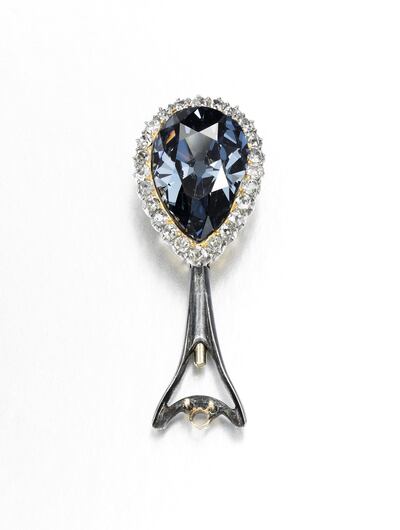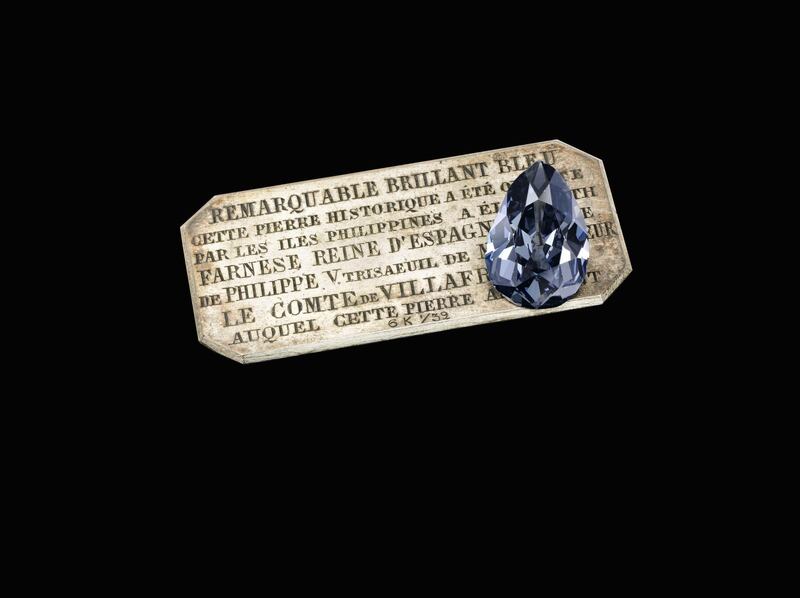Until the discovery of diamond mines in Brazil in the 1720s and subsequent unearthings in Africa and Asia, India's Golconda mines were considered the only source of the precious stones. Owing to the high quality of the gems, and the fact that the mine is now defunct, when the odd Golconda diamond makes its way to the market, it is much sought after by collectors. The Farnese Blue is one such stone, notable not only for its rarity, but also its aristocratic provenance. The diamond will be put up for sale for the first time in its history – having remained in the same family for more than 300 years – at the Sotheby's Magnificent and Noble Jewels auction on May 15 in Geneva.
The colouring, too, is key. Blue has long been viewed as the colour of royalty, and diamonds of this hue were considered most suitable gifts for kings and queens. Accordingly, when a wedding date was set for Elisabeth Farnese of Parma to King Philip V in 1714, the Spanish government's finances were gravely depleted because of the War of the Spanish Succession. But an appropriate dowry for the future queen of Spain had to be found, so the government sent word to the heads of its colonies from Mexico to the East Indies, entreating them to send wedding presents to Madrid. The Golden Fleet, a dozen ships carrying almost their weight's worth in gold bullion and a casket of emeralds, sailed from Cuba, only to be destroyed by a hurricane in the gulf of Florida. A lone ship managed to escape and, while the emeralds were never found, one 6.16-carat pear-shaped blue diamond made its way to Spain, gifted to the new queen by the governor of the Philippine Islands.

Over the next three centuries, the diamond travelled across Europe, worn by both men and women, as Elisabeth and Philip's descendants married into some of the world's most important dynasties. From the dukes of Parma and Lucca to the king of Etruria and even Marie-Antoinette's daughter and granddaughter, the Farnese Blue passed through four royal family trees. The gregarious Charles II had it placed in a tie-pin setting, while Marie-Thérèse – the first child of Louis XVI and Marie-Antoinette – mounted it on a diadem. However, its existence was never publicly acknowledged, until now, and it was said to be stored and transported in a secret royal casket. The Farnese Blue's legacy and lineage is only known because of the detailed written inventory of the family jewels compiled by Maria Anna von Habsburg, the former archduchess of Austria.
David Bennett, chairman of Sotheby’s International Jewellery Division and co-chairman of Sotheby’s Switzerland, says: “It is difficult to put into words the excitement of holding between thumb and forefinger a gem discovered centuries ago, knowing it originated in the legendary diamond mines of India. This stone has witnessed 300 years of European history, and in colour is reminiscent of historic Golconda blue gems.” He intimates that the diamond comes to the market at a moment when interest in aristocratic provenance is at an all-time high; since Sotheby’s inaugural Noble Jewels sale in 2007, the auction house has sold more than 1,100 lots of this type, for a total of almost US$285 million (Dh1.04 billion).
Philipp Herzog von Württemberg, chairman of Sotheby's Europe and managing director of Sotheby's Germany, adds: "With its incredible pedigree, the Farnese Blue ranks among the most important historic diamonds in the world. From the first minute I saw the stone, I could not resist its magic and, as such, it is a huge privilege to have been entrusted with this sale." The diamond is estimated to sell for between $2.7m and $5.3m (up to Dh19.4m) when it goes under the hammer next month, with interested collectors from the UAE able to bid online by or before May 15.
____________________
Read more:
[ Diamond from the sky may have come from ‘lost planet’ ]
[ A crypto asset backed by diamonds launches in Dubai ]
[ William Dalrymple reveals the dark secrets of the Koh-i-Noor diamond ]
____________________












